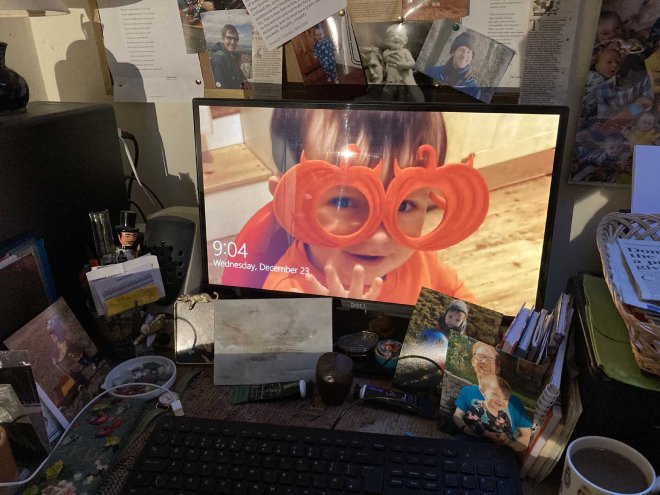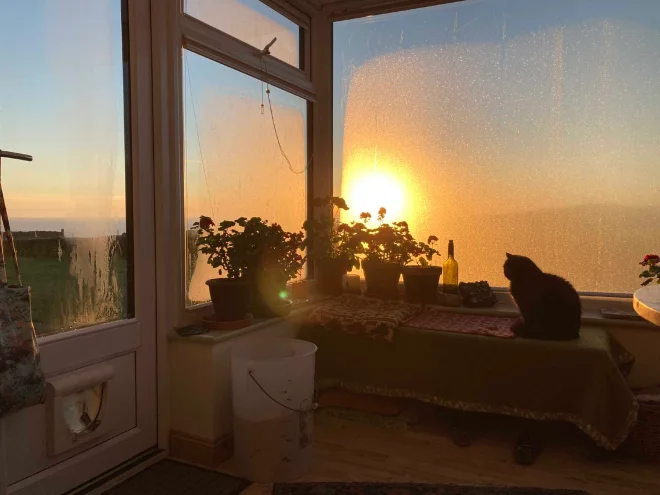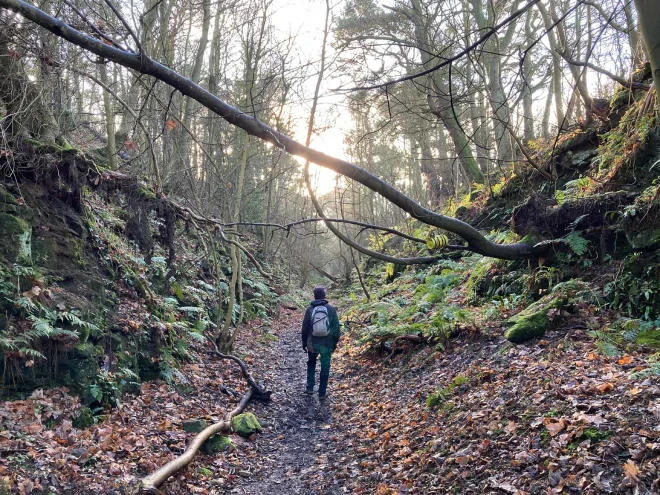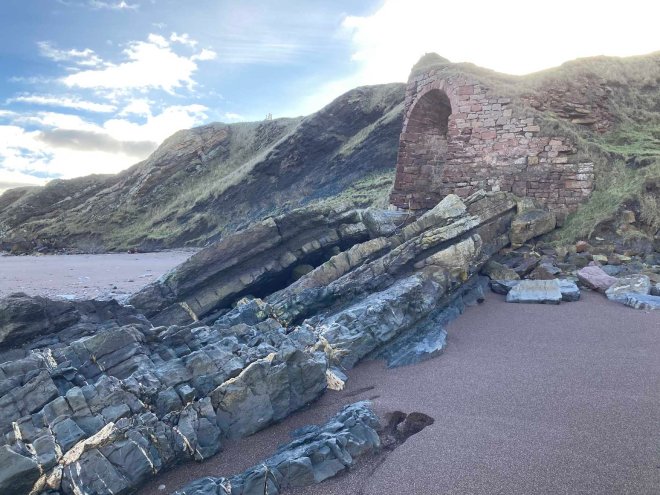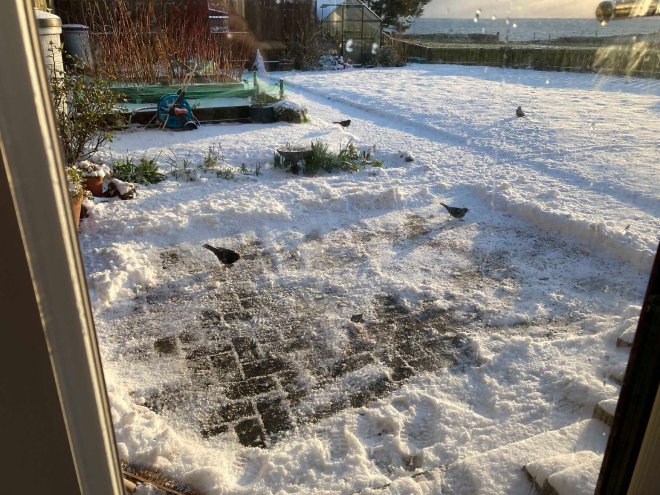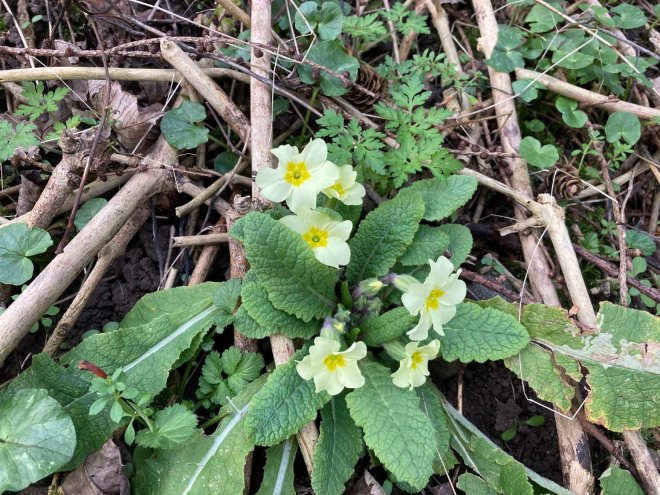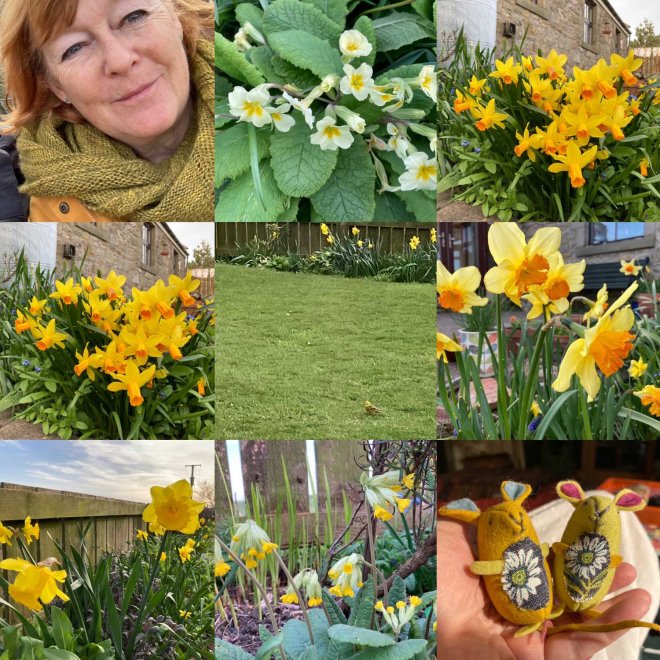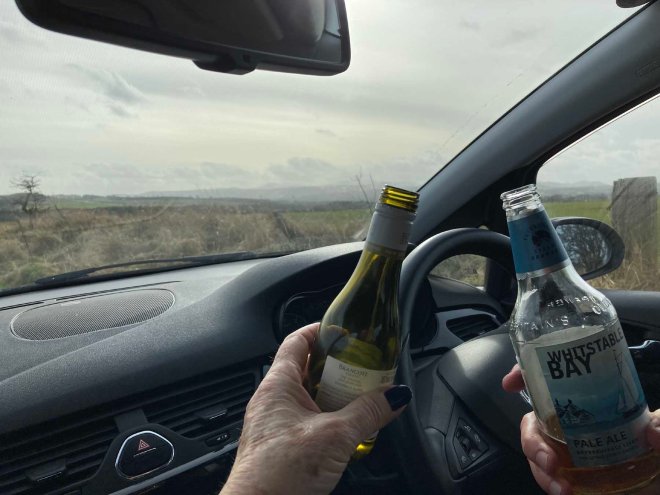By a remarkably fortuitous chance, in the last fortnight we have seen two of the most wonderful Anglo-Saxon pieces of faith and art: the Bewcastle Cross … and the Lindisfarne Gospels …
and the Lindisfarne Gospels … Both of them date from the 7th – 8th centuries and were products of the golden age of the Kingdom of Northumbria.
Both of them date from the 7th – 8th centuries and were products of the golden age of the Kingdom of Northumbria.
They are jaw-droppingly extraordinary. It goes without saying that this is firstly because they are so very old and so very beautiful.
But further. The Bewcastle cross is carved from a single piece of sandstone and stands outside in all weathers, as it has since it was carved over 1200 years ago.
The Lindisfarne Gospels are believed to be all the work of one man, the extremely talented Bishop Eadfrith, – and they have survived Viking raids, falling in the sea as the monks fled these same Vikings and desecration by King Henry VIII’s commissioners when they dissolved the monastery at Durham. They are much travelled …
*********************************************************************
Towards the end of September we headed for the Cumbrian fells … This is one of the wildest places in England – north, north, north, beyond Carlisle, and approaching the border with Scotland. Backroads here now, but in Roman times Maiden Road ran past this lonely spot, linking Birdoswald fort with Hadrian’s Wall. The Romans built a fort here too, and, later, in the eleventh century, a castle was built on the site of the Roman fort. Today the church and its graveyard sit next to the castle …
This is one of the wildest places in England – north, north, north, beyond Carlisle, and approaching the border with Scotland. Backroads here now, but in Roman times Maiden Road ran past this lonely spot, linking Birdoswald fort with Hadrian’s Wall. The Romans built a fort here too, and, later, in the eleventh century, a castle was built on the site of the Roman fort. Today the church and its graveyard sit next to the castle … As you approach the little church of St Cuthbert, you get your first glimpse of the cross standing almost insignificantly beside the church …
As you approach the little church of St Cuthbert, you get your first glimpse of the cross standing almost insignificantly beside the church … But of course, it isn’t insignificant. It’s gorgeous with carvings of saints and trailing leaves, and fruits, and intertwining patterns …
But of course, it isn’t insignificant. It’s gorgeous with carvings of saints and trailing leaves, and fruits, and intertwining patterns … Even more extraordinary, it is thought that it was originally painted in bright colours. Though I think to our modern eye, the more subtle colours of the stone are perfectly beautiful in this rural setting …
Even more extraordinary, it is thought that it was originally painted in bright colours. Though I think to our modern eye, the more subtle colours of the stone are perfectly beautiful in this rural setting … There is a tiny museum attached which gives helpful information and pictures of this cross (so-called even though it is missing the cross shaft at the top). The people carved on the stone are thought to be St John the Baptist holding the lamb of God at the top, Christ in the middle, and possibly St John the Evangelist with his eagle at the bottom …
There is a tiny museum attached which gives helpful information and pictures of this cross (so-called even though it is missing the cross shaft at the top). The people carved on the stone are thought to be St John the Baptist holding the lamb of God at the top, Christ in the middle, and possibly St John the Evangelist with his eagle at the bottom … The clue to the why and wherefore of this cross is in the church’s dedication to St Cuthbert …
The clue to the why and wherefore of this cross is in the church’s dedication to St Cuthbert … Step back those 1200 years or so, and these Cumbrian lands were part of the sizeable kingdom of Northumbria. The kingdom stretched from Edinburgh down to the Humber river, and over from Carlisle on the west coast to Bamburgh on the east. With the conversion of the Northumbrian King Oswald to Christianity, missionaries – inspired by St Cuthbert’s life of sanctity – set out to convert the rest of Northumbria. Preaching crosses such as the Bewcastle cross were set up to remind people of the Christian story they had newly learned.
Step back those 1200 years or so, and these Cumbrian lands were part of the sizeable kingdom of Northumbria. The kingdom stretched from Edinburgh down to the Humber river, and over from Carlisle on the west coast to Bamburgh on the east. With the conversion of the Northumbrian King Oswald to Christianity, missionaries – inspired by St Cuthbert’s life of sanctity – set out to convert the rest of Northumbria. Preaching crosses such as the Bewcastle cross were set up to remind people of the Christian story they had newly learned.
The Bewcastle cross is believed to have been commissioned by Benedict Biscop whom we met briefly in my last blogpost on Bede. Benedict Biscop was Abbot of Monkwearmouth. And it was his monks from Monkwearmouth monastery who are thought to have carved the Bewcastle cross … They were spreading the Word from the eastern shores of northern England where St Cuthbert once preached and worshipped on the Holy Island of Lindisfarne …
They were spreading the Word from the eastern shores of northern England where St Cuthbert once preached and worshipped on the Holy Island of Lindisfarne … As was Bishop Eadfrith of Lindisfarne who is believed to be the creator of the Lindisfarne Gospels.
As was Bishop Eadfrith of Lindisfarne who is believed to be the creator of the Lindisfarne Gospels.
Preaching crosses told Christian stories for the hoi polloi (who couldn’t read), but the educated and learned religious were gradually acquiring access to books.
*********************************************************************
We visited Newcastle’s Laing Gallery last week to see the Lindisfarne Gospels – a rare and precious trip north from their usual home at London’s British Library. The book was open at the beginning of the Gospel of St John, with its so-called carpet page on the left and “incipit” (introductory) page of the right …
It’s hard to explain the sense of awe this one book inspires. It is so very very old, carries with it such a story, and contains such exquisite workmanship.
Everything from the choice of smooth creamy perfectly-scraped calfskin to the still-bright colours (red lead, verdigris, orpiment, carbon, indigo and woad) and tiny gold highlights is just perfect.
Each Gospel writer gets a carpet page and an introductory page at the beginning of their writing – this is St Matthew’s carpet page … And this is the introductory page. The detail is exceptional, this is truly the work of someone with a remarkable imagination …
And this is the introductory page. The detail is exceptional, this is truly the work of someone with a remarkable imagination … But it is striking that you’re seeing here the same curls and whorls, similar interlacing patterns with animals and beasts and fruits and flowers all worked in together as those that are carved on to the Bewcastle cross. Perhaps we need to take a step further and imagine that sandstone cross as it might once have been, painted in these colours …
But it is striking that you’re seeing here the same curls and whorls, similar interlacing patterns with animals and beasts and fruits and flowers all worked in together as those that are carved on to the Bewcastle cross. Perhaps we need to take a step further and imagine that sandstone cross as it might once have been, painted in these colours …
And it’s worth remembering that Bishop Eadfrith worked on these gospels in the harshest of harsh conditions. Lindisfarne at this time boasted no stone buildings, no glass windows. The winds howl in from the North Sea.
We visited one November several years ago when the mist lay heavy and unmoving. Just driving over the causeway was disconcerting. These are the dank, dark conditions Eadfrith would regularly have been working in … It’s easy to get waylaid by the beauty and skill in these objects. But it’s important to remember that they were produced in faith for the furthering of faith. The creators strove to do the best they could for this purpose. All to the glory of God, not for their own aggrandisement or pleasure.
It’s easy to get waylaid by the beauty and skill in these objects. But it’s important to remember that they were produced in faith for the furthering of faith. The creators strove to do the best they could for this purpose. All to the glory of God, not for their own aggrandisement or pleasure.
I believe those men would like to think that the Bewcastle cross and the Lindisfarne Gospels still cause us to stop and reflect on our life’s journey – even if we cannot agree with everything that Bede says below …



















































 On the back, I followed Rebecca Page’s suggestion and put a pond – with lots and lots of weird and wonderful animals stitched into this colourful collage. Plus some finger puppets to play with (a Zero, of course) …
On the back, I followed Rebecca Page’s suggestion and put a pond – with lots and lots of weird and wonderful animals stitched into this colourful collage. Plus some finger puppets to play with (a Zero, of course) …







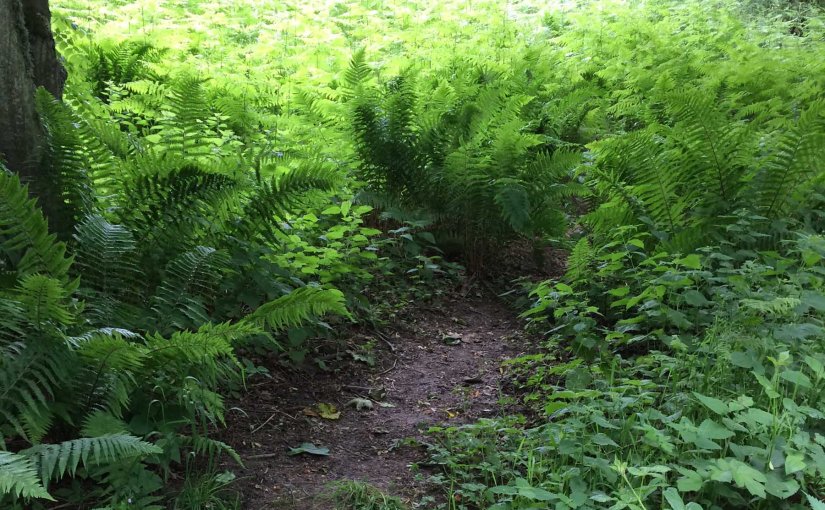























 Which calls to mind this beautiful poem by Spanish poet, Antonio Machado …
Which calls to mind this beautiful poem by Spanish poet, Antonio Machado …


























































































































